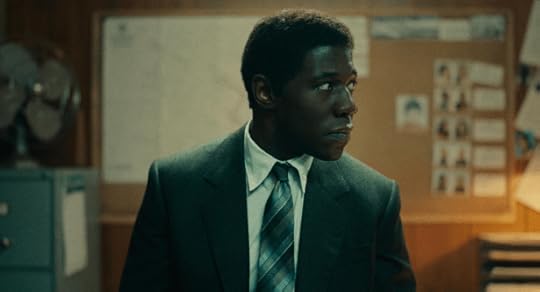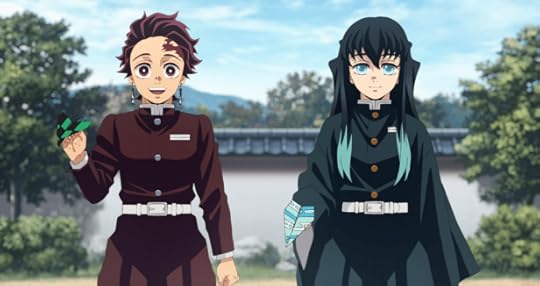Sneha Jaiswal's Blog, page 97
June 3, 2024
Eric Review – Retro Thriller That Embraces Its Monsters




Sneha Jaiswal (Twitter | Instagram)
Dads can be big, scary creatures, casting shadows that haunt a child for the rest of their lives. But the thing is, sometimes even the biggest, meanest, and seemingly awful fathers can love their kids just as much as “mom of the year” types. Too bad they don’t know how to channel their affection in a way that won’t result in years of therapy for their children. “Eric”, the 2024 Netflix series is led by one such dad, diving into the world of grief-stricken, alcoholic-workaholic creative Vincent Anderson (Benedict Cumberbatch), who spirals after his 9-year-old son Edgar goes missing and starts talking to an imaginary monster while working on finding his boy.
Created by Abi Morgan and Lucy Forbes, “Eric” spans six tightly paced episodes with two parallel stories. One focuses on Vincent Anderson (Benedict Cumberbatch), a puppeteer and showrunner for “Good Morning Sunshine,” a Sesame Street-like kids’ show. The other follows NYPD Detective Michael Ledroit (McKinley Belcher III) as he searches for Vincent’s missing son, Edgar Anderson (Ivan Morris Howe), and investigates a potential link to another missing boy’s case from the same area. How these two starkly different men attempt to track Edgar forms the crux of the tale.
Edgar Anderson is a bright, creative child like his father and goes missing one morning after witnessing an awful argument between his parents. Did he run away to escape the screaming matches at home, or was he kidnapped to be trafficked? There’s significant suspense and tension throughout “Eric” regarding Edgar’s fate in the show. The boy had pitched a new puppet character named Eric to his dad just a day before, so when Edgar disappears, Vincent starts talking to the imaginary monster Eric as a coping mechanism, convinced Eric will somehow lead him to his son. “You’ve gone crazy again,” is something Vincent is told more than once.

Benedict Cumberbatch is in his element, brilliantly portraying yet another genius variant (Sherlock Holmes, The Imitation Game, Doctor Strange) – Vincent Anderson is an odiously narcissistic artist with severe alcohol issues and unresolved parental problems. He’s obnoxious, foul-mouthed, and egocentric, and his love for Edgar adds the only layer of humanity to his character. A significant part of “Eric” explores Vincent’s strained relationships, from his wife Cassie (Gaby Hoffman) to his best friend Lennie (Dan Fogler), who works with him on “Good Morning Sunshine.” Cumberbatch makes you both despise Vincent yet empathize with his character’s ordeal of losing his only son. Despite what the title suggests, the imaginary monster Eric doesn’t get much screen time.
Set in the 1980s, the cinematography is distinctly retro, mixing the flashy disco era with New York’s grimy streets. The puppets are the only innocent, colorful touch in this dark, somber series. “Eric” starts as a mystery about Edgar’s disappearance but evolves into a complex web of strained human relationships and the exhaustion that comes with it. The show delves into various themes, including New York’s homelessness crisis, crime rate, child abuse, racial discrimination, rampant homophobia, and police corruption, among other things.

McKinley Belcher III stands out as the biggest hero in “Eric,” portraying the honest, hardworking, closeted NYPD detective Michael Ledroit. He leaves no stone unturned in finding Edgar. Ledroit suspects a shady, queer-friendly club called the Lux might be involved in Edgar’s disappearance, as it’s run by ex-con Alexander Gator (Wade Allain-Marcus) formerly involved in trafficking underage boys. While the focus on Ledroit’s personal life occasionally slows the show’s pace, it helps establish a deeper emotional connection between his character and the viewers. At work, Ledroit feels discriminated against as a black, closeted cop and is accused of perpetuating the same bias by targeting black suspects and ignoring black victims.
Adepero Oduye is poignant in her cameo as grieving mother Cecile, whose son Marlon Rochelle went missing in the same area as Edgar over a year ago. She calls out the system for the blatant devaluation of black lives, as Marlon’s case didn’t receive the same media attention as Edgar’s. Ledroit continues his investigation into Marlon’s case, eventually uncovering the tragedy that befell the boy. It’s a shame that one crucial supporting character however is completely forgotten towards the end.
The climax delivers a triumphantly cinematic poetic justice, with Vincent Anderson perhaps getting a “too good to be true” redemptive arc. But all’s well that ends well? For some viewers, “Eric” might feel fragmented due to the multiple themes tackled in just six episodes. However, for those who enjoy shows with flawed, twisted protagonists, the series is entirely binge-worthy.
Rating: 7.5 on 10. Stream “Eric” on Netflix.
Read Next: Baby Reindeer Review – Traps You In Its Warped Quicksand of Abuse
Also Read: Mother-Daughter Murder Night Book Review (Audio version below)
June 2, 2024
Demon Slayer Hashira Training Arc – Ep 4 Review
Follow us on Twitter | Instagram
Tanjiro Kamado has already completed rigorous training with ex-Hashira Tengen Uzui, and as teased at the end of episode 3 of the Demon Slayer: Hashira Training Arc, he is now headed to train under the green-eyed Mist Hashira, Muichiro Tokito.
Titled “It Makes You Smile,” episode four of the Demon Slayer: Hashira Training Arc opens with Tokito swiftly ‘killing’ his juniors in mock battles as Tanjiro enters his training quarters. While Tokito wasn’t as seriously injured as Tanjiro during their battle against upper-level demons in the Swordsmith Village, the two have developed a certain kinship, reflected in Tokito’s softer treatment of Tanjiro in this edition of Demon Slayer. From being completely expressionless while training the others, his face completely lights up with a smile when he spots Tanjiro at his door. They are both in top form, eager to take on new demons and defeat Muzan Kibutsuji.
This was a largely relaxed episode, mostly focused on Tokito rigorously training lower-level demon slayers throughout the day and then jetting off at night to do his own thing. The animation is a lot more enjoyable in this installment, showcasing Tokito’s expertise as a swordsman and his dedication to improving his juniors’ armed combat skills, resulting in plenty of fencing scenes. The creators also deliver the promised fight between Wind Hashira Sanemi Shinazugawa and Serpent Hashira Obanai Iguro, but with an exciting twist!

True to its title, “It Makes You Smile,” the episode feels like a filler designed to entertain. However, given the progression of the Hashira Training Arc, the entire season might serve as a laidback appetizer before the inevitable bloody battle between demons and slayers. Everyone is acutely aware that the demons haven’t been terrorizing civilians as usual, heightening the tension over their plans. Most of the Slayer Corps believes Muzan Kibutsuju is merely biding his time before he and his followers attempt to capture Nezuko, the only demon who has successfully conquered sunlight.
Until the demons make their move, Tanjiro and the other slayers must focus on training hard to be prepared for the inevitable war.
You can stream the series on Netflix, CrunchyRoll and JioCinema.
Read Next: My Oni Girl Review – Spirits You Away to Snoozeland
Also Read: Mother-Daughter Murder Night Book Review (Audio version below)
Godzilla Minus One Review: Giant-Sized Guilty Pleasure
Sneha Jaiswal (Twitter | Instagram)
The Japanese film “Gojira -1.0” – Godzilla Minus One is now available to watch on OTT (Netflix) and anybody looking for a larger-than-life “Monsters versus Humans” movie should just go stream it. Godzilla, of course, is the only crazily unreal thing in this otherwise serious story, which delves into the themes of human resilience in the face of destruction and tragedy.
Directed by Takashi Yamazaki, “Gojira -1.0” / “Godzilla Minus One” stars Ryunosuke Kamiki as Koichi Shikishima, a fighter pilot who arrives at Odo Island for a brief respite from World War II, only to witness a terrifying dinosaur-like monster known as Godzilla emerge from the ocean and kill everyone on the island except him and a technician. Shikishima survives the war unscathed but suffers severe PTSD, which only worsens when Godzilla re-emerges to wreak havoc on Tokyo. Abandoned by all allies, Japanese citizens must come up with a plan to save themselves from the colossal sea monster.
Takashi Yamazaki and writers Ishirô Honda and Takeo Murata pull no punches in criticizing the Japanese regime for exploiting its soldiers during World War II, sending them on suicide missions with no regard for their lives. Sample the following dialogue from a scene in “Gojira -1.0” / “Godzilla Minus One,” where a strategy meeting is ongoing to discuss how to neutralize Godzilla:
“Does this plan of yours mean certain death?”
“Of course it doesn’t!”
“Okay. Well, those odds are better than the war.”
The meeting room breaks into soft laughter; it’s a tragicomedy scene where facing a near-invincible gigantic monster seems less risky than going to the front line. Like the original 1954 Ishiro Honda movie “Godzilla,” this newer version retains the same themes, with the monster serving as a clever metaphor for war—aimless, except for its drive to annihilate humans. And yet, Godzilla somehow seems to be a lesser evil than actual war.

Ryunosuke Kamiki delivers a spirited performance as protagonist Koichi Shikishima, whose character undergoes significant growth over the two-hour runtime, evolving from a nervous, shifty fighter pilot who abandons his duties to a determined young man seeking redemption. Post-war, he finds himself a dangerous job to scan naval mines in the sea, and ends up being part of Tokyo’s efforts to defeat Godzilla.
The special effects in the film are engaging, even though the character design for Godzilla is only a mild upgrade from its older onscreen depictions and looks ridiculously fake. However, its unnaturally hideous appearance lends “Godzilla Minus One” a subtle comical undertone, which ups its entertainment value. While I didn’t like the special effects for Godzilla at all, the rest of the effects in the movie are well executed and engaging to watch.
Director Takashi Yamazaki lulls you into expecting a tragic climax but surprises viewers with a clichéd yet satisfying ending. Overall, “Gojira -1.0” / “Godzilla Minus One” is the kind of guilty pleasure movie you can enjoy without worrying too much about logic and details.
You can watch “Godzilla Minus One” on Netflix.
Read Next: City Hunter: Ryohei Suzuki’s Ryo Saeba Is Foxily Comical
Also Read: Mother-Daughter Murder Night Book Review (Audio version below)
June 1, 2024
Rivers Review – A Weird, Disjointed Graphic Novel



Sneha Jaiswal (Twitter | Instagram)
Half-way through the graphic novel “Rivers” by David Gaffney and Dan Berry, I wasn’t sure if I wanted to continue reading it, because it had multiple protagonists, all of them going through extremely different things, so it all felt extremely random. However, towards the end, David Gaffney merges all the seemingly haphazard paths together to give readers a wistful ending, which is partially contrived yet slightly satisfactory. “At least it all makes sense now!,” was my key takeaway.
“Rivers” starts with a flashback of two school-boys reading a comic called “Revenge of the Ghoulors”, the panels of which makes their way into the graphic novel – a colorful retro sci-fi tale about two intergalactic aliens who hunt monstrous entities. Where these two kids from the flashbacks fit into the main story isn’t revealed until the very end of the graphic novel. In the current timeline of “Rivers”, there seem to be three different protagonists – Heidi, an introvert who works from home and obsesses over an app about dreams; Gideon, an awkward, asocial I.T guy who is on the verge of developing a possible romantic connection with a co-worker; and Peter, a divorcee in his 50s who sells old cars and seems like a cheery wacko.
Given the multiple protagonists who have nothing to do with each other, I was very confused about what was happening in “Rivers” for almost 60 percent of the graphic novel. Eventually, it turns into a weirdly emotional story about past trauma, nostalgia, and grief. Thankfully, all three diverse characters do end up having something that connects them. It is Heidi’s activity on the dream site that brings them together, which is one of the most fun concepts in the story—a site where people can anonymously write about their dreams, and others can reach out to them if they want to.
The artwork by Dan Berry is simple, doodle-style, with a sober color palette, and while not striking, it’s engaging enough for the offbeat, fragmented story. At one point in the book, I was pretty sure I wouldn’t be able to rate this graphic novel, just because the plot progression wasn’t very interesting to me, yet, at the same time seemed like the kind of existential genre some readers would be able to find some thrills in.
Rating: 3 on 5. “Rivers” is also on Kindle Unlimited.
Read Next: Lore Olympus Season 1 Review
Also Read: Mother-Daughter Murder Night Book Review (Audio version below)
Kolory zla. Czerwien – ‘Colors of Evil: Red’ Review
Sneha Jaiswal (Twitter | Instagram)
Director: Adrian Panek
Writers: Lukasz M. Maciejewski, Adrian Panek, Malgorzata Oliwia Sobczak
When a young woman’s naked body is washed up on a beach, autopsy reveals she was brutally killed in the same manner as another murder victim from 15 years ago. An ambitious prosecutor begins to dig deeper into the case and teams up with the victim’s mother to unearth the truth when he discovers an uncannily sinister connection between the cases.
The Polish thriller “Colors of Evil: Red” (Original title: Kolory zła. Czerwień) stars Jakub Gierszał as the honest, upright law enforcement officer Leopold Bilski, who is intent on finding the true culprit behind Monica Bogucka’s (Zofia Jastrzębska) murder even after an arrest is made and the case is closed. He works with Monica’s mother, Helena Bogucka (Maja Ostaszewska), who is also convinced her daughter’s killer is still out there. The club where Monica worked becomes the primary focus of their investigation, and as more clues emerge, Leopold begins to suspect there might be many more victims.
Those who find sexual violence upsetting, will have an uncomfortable time watching “Colors of Evil: Red”, even though director Adrian Panek sparingly steers the tale with stark graphic visuals, instead letting characters describe several of the grisly details of how the victims were savagely murdered and even that made me flinch. It’s one of the rare times when I was thankful the creator chose to “tell” some of the plot details instead of showing them.

What happened to Monica Bogucka in the weeks before her death is shown in flashbacks, with Zofia Jastrzębska portraying a beautiful, confident barkeep who becomes involved with the wrong kind of men. The fact that Monica’s mother is a judge and her father a lawyer immediately establishes what seems like an annoying power paradox in the tale, which is explained in the second half but isn’t entirely convincing.
Maja Ostaszewska delivers an emotionally rousing performance as Helena, who completely breaks down after Monica’s death but then picks herself up and starts seeking justice for her daughter. However, one would have expected her character, as a seasoned judge, to exhibit more grit, sass, and fortitude instead of the jittery demeanor portrayed under the direction. Przemyslaw Bluszcz as a deviant crime boss Lukasz Kazarski AKA ‘Kazar’, one of the antagonists in “Colors of Evil: Red” is intimidatingly good. Despite limited screen-time, he manages to leave a disturbing impression as a drunk-on-power kingpin who thinks he is invincible.
At 1 hour and 51 minutes, “Colors of Evil: Red” maintains a steady pace throughout most of its runtime, presenting a straightforward yet disturbing murder mystery due to the gory nature of the killings. However, the climax introduces a surprisingly tragic twist that isn’t adequately foreshadowed, but at least gives a conclusive ending and closure to the investigation. The film raises pertinent questions about sexual violence against women without providing answers, which may prove frustrating and difficult for some viewers. Nonetheless, it is an intriguing one-time watch for thriller fans.
Rating: 6.5 on 10. You can stream “Colors of Evil: Red” on Netflix.
Read Next: Influencer Review – Picture-Perfect Preys
Also Read: Mother-Daughter Murder Night Book Review (Audio version below)
May 31, 2024
Bake Me Please Review – Half-Baked


Follow us on Twitter | Instagram
Director: Kanchanapun Meesuwan
Writers: Piyaros Sunthornwiphart, Danuphon Chaimueanwong
Thai series “Bake Me Please” follows Shin (Ohm Thitiwat Ritprasert), an asocial, strict, uptight pâtissier who runs a bakery with his friends, popular for his Torta Caprese, a classic Italian dessert. When aspiring baker Peach (Guide Kantapon Chompupan), an avid home-baker joins their team, Shin is completely hostile towards him, but the two warm up to each other as they start baking together. Spanning six episodes, “Bake Me Please” is a straightforward “hostile strangers to lovers” tale.
Last seen in the chaotic time-travel romance ‘609 Bedtime Story’ with Fluke Natouch Siripongthon, Ohm Thitiwat Ritprasert plays a variation of the same tsundere protagonist Shin in “Bake Me Please” – the kinds who appears cold and tough towards their love interest at first and then turns soft and sweet. But Ohm has a limited range of expressions and his onscreen chemistry with Guide Kantapon Chompupan is minimal, even though the latter is quite earnest in his role as Peach. Instead, there are more sparks between Peach and Shin’s colleague Guy (played by Poom Phuripan Sapsangsawat), than with Shin. Atom Nathaphop Kanjanteak as Peach’s friend Atom provides some mild comical relief in the series, as an aimless guy who is learning to bake because of his bossy mom.
Even though “Bake Me Please” could have been a simple, formulaic yet enjoyable romantic series, the lack of chemistry between the leads makes it dry and dull. A subplot involving Peach’s grandmother, who sells cakes, is sweet, but the grandmother’s character is as clichéd as can be—a kind, maternal old lady who always gives out sage, repeated advice about how delicious food is made from the heart. It’s a good thing that the show is only six episodes long, because the writers simply run out of material to keep the story interesting.
Overall, “Bake Me Please” fails to be engaging, and if you’re looking for a food-based Thai BL series, check out “Moonlight Chicken” instead.
Read Next: Boys Be Brave! Review – Adorbs In Chunks
Also Read: Mother-Daughter Murder Night Book Review (Audio version below)
Vance – Short Film with a Bite
Find us on Twitter | Instagram
Vance is a vampire contemplating the end of his endless existence when he meets a vivacious young woman named Cat, making him rethink his pessimism about eternal life.
Written and directed by Dakota Daulby, “Vance” is a 12-minute short film starring Harrison Houde as the titular lead. Set in a world where humans and vampires coexist peacefully, with supermarkets selling bottled blood for vampires to consume, the story is a light-hearted take on what it means to be young forever while one’s human family and friends age and succumb to the cycle of life and death.
Harrison Houde might remind some viewers of a young Nicholas Hoult from the 2013 horror-comedy “Warm Bodies,” where Hoult played a zombie who develops a relationship with a human girl. Similarly, “Vance” features a supernatural entity forging a bond with a human. However, Vance the vampire is just as intelligent and sentient as humans, unlike a zombie.
The cinematography gives the movie a retro 90s neon vibe, with dimly lit shots. For a 12-minute short, “Vance” is a quirky film that packs in numerous themes and pop culture references, including a nod to the classic gothic horror novel and film “Interview with the Vampire,” featuring a girl vampire character seemingly fashioned after Claudia.
You can watch “Vance” on YouTube.
Read Next: Maxton Hall: The World Between Us Series Review
Also Read: Mother-Daughter Murder Night Book Review (Audio version below)
May 30, 2024
Influencer Review – Picture-Perfect Preys



Find us on Twitter | Instagram
Social media influencer Madison is on a solo trip to Thailand when she befriends the enigmatic CW, who shows her stunning spots but has a twisted ulterior motive for getting close to her.
Director Kurtis David Harder has co-written the thriller “Influencer” with Tesh Guttikonda, dwelling into the perils of getting to cozy with a stranger while you’re traveling alone. It opens with a gorgeous drone shot of an island, with the camera slowly getting closer to a pristine beach, the scene marred by what looks like a dead body of woman, with her face buried in the sand. The ominous moment is swiftly replaced by the chirpy voice of influencer Madison (Emily Tennant) spouting quotes about the wonderful benefits of travel, unaware of the terrors the trip will bring.
Within its first few minutes, “Influencer” takes clever digs at social media personalities who project having fabulous lives on their feeds. Off the camera, when her thousands of “followers” aren’t watching, Madison is absolutely lonely and miserable on her Thailand trip, despite its glorious sunsets and insta-worthy hotels. Cassandra Naud is sharp, self-assured as the antagonist CW, a young woman who knows her way around Thailand, and preys on influencers like Madison.

Divided into four acts, “Influencer” is swiftly paced for a thriller, even though CW’s motives aren’t clearly established and viewers are expected to read between the lines. She is either a sadistic criminal who derives joy from crushing others or someone who enjoys living vicariously by hijacking her victims’ lives for a while. “Nobody will even notice you’re gone,” is her trademark line, which jeers at the hollow connections made by the supposedly popular women she targets. But the writers don’t dwell to deeply into any of the themes they set out to explore, which given the 90-minute runtime, was probably never an option.
The cinematography shows off some of Thailand’s gorgeous tourist spots, the background track maintains significant suspense through the runtime. There are several plot points in “Influencer” that wouldn’t make much sense in real-life scenarios. For instance, CW’s victims stay in super-fancy hotels, which would ideally have CCTV cameras to capture suspicious activity. But maybe she is just super lucky? Despite its flaws, the thriller is an engaging one-time watch that delivers a climax with poetic justice.
You can stream “Influencer” on Prime Video.
Read Next: Maxton Hall: The World Between Us Series Review
Also Read: Mother-Daughter Murder Night Book Review (Audio version below)
10 Hit Korean Dramas Adapted From Japanese Manga
Follow us on Twitter | Instagram
Japanese manga has taken the world by storm, captivating readers far beyond the shores of Japan. These illustrated novels offer something for everyone, from epic adventures and heartwarming romances to spine-chilling horrors and quirky comedies. Whether it’s a high-school drama or a fantastical quest, the transition from page to live-action has become a thrilling trend, delighting fans and introducing new audiences to the rich tapestry of manga storytelling. Here is a list of 10 popular Korean series that are based on Japanese manga:
“Boys Over Flowers” (2009)Adapted from the beloved manga “Hana Yori Dango” by Yoko Kamio, this Korean drama follows the story of a resilient young woman from a modest background who finds herself entangled with a group of wealthy and influential boys at an elite high school. Filled with romance, drama, and intrigue, it explores themes of social class, friendship, and self-discovery.“To The Beautiful You” (2012)
Inspired by the manga “Hana-Kimi” by Hisaya Nakajo, this series tells the tale of a girl who disguises herself as a boy to enroll in an all-boys high school where her idol, a high jump athlete, attends. Amidst the challenges of concealing her true identity, she navigates the complexities of friendship and love.“City Hunter” (2011)
Based on the manga by Tsukasa Hojo, “City Hunter” chronicles the adventures of a skilled vigilante seeking justice for his father’s death while operating in the shadows of Seoul. With action-packed sequences, political intrigue, and a touch of romance, it captivates viewers with its gripping storyline and dynamic characters.“Cantabile Tomorrow” (2014)
Adapted from the manga “Nodame Cantabile” by Tomoko Ninomiya, this drama follows the journey of a talented pianist as he navigates the world of classical music alongside his eccentric fellow students. Filled with humor, romance, and musical performances, it offers a delightful portrayal of passion and friendship.“Liar Game” (2014)
Based on the manga by Shinobu Kaitani, “Liar Game” centers around a psychological survival game where contestants must outwit each other to win. As alliances form and betrayals unfold, the series explores themes of trust, deception, and human nature in a high-stakes setting.“Bride of the Water God” (2017)
Inspired by the manga by Yoon Mi-kyung, this fantasy romance follows the story of a water god who descends to the human world and falls in love with a mortal woman destined to be his bride. Set against a backdrop of divine realms and earthly conflicts, it weaves together themes of love, destiny, and sacrifice.“Orange Marmalade” (2015)
Adapted from the manga by Seok Woo, “Orange Marmalade” portrays a world where vampires face discrimination and prejudice. Amidst societal tensions, a vampire girl strives to lead a normal high school life while navigating the complexities of friendship and romance.“Fated to Love You” (2014)
Based on the manga by Yuan Xiang Qin, “Fated to Love You” follows the unexpected journey of a young woman whose life takes a dramatic turn after a fateful encounter with a wealthy CEO during a company retreat. Filled with humor, heartache, and heartfelt moments, it explores the intricacies of fate and love.“Tomorrow’s Cantabile” (2014)
Inspired by the manga “Nodame Cantabile” by Tomoko Ninomiya, this drama portrays the world of classical music through the eyes of a passionate young conductor and his talented but eccentric peers. With its charming characters, comedic moments, and musical performances, it offers a heartwarming tale of pursuing one’s dreams.“The Smile Has Left Your Eyes” (2018)
Adapted from the manga “Sora Kara Furu Ichioku no Hoshi” by Miyabe Miyuki, this psychological thriller follows the complex relationship between a mysterious man with a troubled past and a woman who becomes entangled in his life. Filled with suspense, mystery, and emotional depth, it explores the darkness that lurks beneath the surface of seemingly ordinary lives.
Read Next: Three Must-Watch Hayao Miyazaki Movies on Netflix
Also Read: Einstein and the Bomb Review (Audio Version Below)
Blood of Zeus Season One Review




Sneha Jaiswal (Twitter | Instagram)
“Heaven has no rage, like love to hatred turned, Nor hell a fury, like a woman scorned” – this popular quote is from the 17th century tragedy “The Mourning Bride” by William Congreve. However, it perfectly defines the Greek Goddess Hera from her portrayal in “Blood of Zeus”, the Netflix animated series created by Charley Parlapanides and Vlas Parlapanides.
Plot Overview: Heron is an impoverished young commoner living with his mother on the outskirts of an ancient Greek village as outcasts because he is a bastard child. Over time, Heron learns he is the son of Zeus and becomes embroiled in a war against a demonic army led by the evil Seraphim. While Zeus tries to guide Heron to victory, his wife Hera plots her own vengeance against the God of Thunder for his many infidelities, with both Heron and Seraphim becoming pawns in the feud between the mighty Olympian couple.
For those familiar with Greek myths and legends, “Blood of Zeus” is not as complex and violent as one would expect it to be, especially considering its 16+ rating in many countries. However, there’s enough blood flowing throughout the first season’s eight episodes to keep viewers nervous about who might die or be mutilated next. I found myself rooting more for Seraphim, the blood-thirsty demonic antagonist, who has a far more tragic back-story than the one-dimensional Heron. But let me write about the most important ingredient of this series first – the animation.

“Blood of Zeus” is produced by Powerhouse Animation Studio, which also worked on “Castlevania” and “Castlevania: Nocturne” and fans of the Gothic series will immediately spot the similarities in illustrations and character designs. In fact, some of the characters look very vampire-like because they resemble “Castlevania” characters. For instance, Hera might remind viewers of Carmilla, the vampire Queen of Styria, just that the Greek Goddess is far more powerful, crafty, but maybe just as ruthless.
For most parts, the animation is definitely engaging; however, the landscapes and background designs aren’t detailed or stunning enough for the many slow-motion shots in the series. Even Mount Olympus doesn’t exude the extravagant Greek grandeur befitting the stature of the Gods. For a brief second, I wondered if the animators simply used Dracula’s castle illustrations and tweaked them to build Mount Olympus for “Blood of Zeus.” Who knows! While I was satisfied with how most of the Greek gods and human heroes look in the show, the character designs for the legendary giants that Zeus and the Olympians battle against were quite underwhelming.The background music on the other-hand consists of a lot of ominous choral flourishes which complement the dark themes of “Blood of Zeus” quite well.
The pace of the series is steady, and despite familiar formulaic sub-plots, the creators manage to keep up steady suspense until the end, making the show binge-worthy. It’s a different story that after keeping you on the edge of your seat in many scenes, the story doesn’t deliver epic twists. Ironically enough, Zeus turns out to be the most flawed yet likable character in the show, he is the OG Lothario, a philandering God with a string of children born out of wedlock, and while he isn’t winning any “father of the year” awards, he at least tries to keep them all safe from Hera’s wrath. Hera makes for an imposing antagonist, blinded by her rage, so much that her actions spell doom for the Gods too. The other characters aren’t as interesting, but they keep things entertaining.
If one had to provide a reductive synopsis for “Blood of Zeus,” you might say: When Zeus has an affair with a human woman, it goes disastrously wrong, igniting a catastrophic war on Earth fueled by Hera’s jealousy. If Greek stories, fantasy fiction, and animation sound like a fun combination to you, definitely check this series out.
Rating: 7 on 10. Watch “Blood of Zeus” on Netflix.
Read Next: Three Must-Watch Hayao Miyazaki Movies on Netflix
Also Read: Mother-Daughter Murder Night Book Review (Audio version below)



